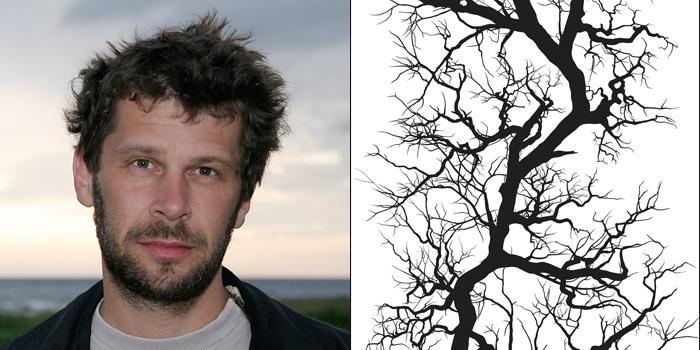
Other areas /
Google Ads
Johan Carpner: To capture the untamable |
SUBSCRIBE SEND AS EMAIL |

|
|
|
Johan Carpner; Detail of 'Vinterek'
|
1 |
|
The beauty of Johan Carpnerís work lies in the way it moves. Not movement as in coaxing three-dimensional depth out of a flat surface, but movement in terms of how easily his style flows between the intense lucidity of his graphic designs and the haunting expressiveness of his textiles.
After working for almost a decade as a graphic designer, Carpner peeled graphic symbols off the printed page and gave them new life as patterns and motifs. Finally free of fonts, templates, and T-squares, Carpner began to express himself in free-flowing organic lines and leafy abstractions. Drawn to serpentine outlines and razor-sharp cut-outs, his textile prints for Swedish luxury retailer Svenskt Tenn stopped onlookers in their tracks. In ĎWinter Oakí, which Svenskt Tenn produced in 2004, the harsh reality of the Nordic winter was recreated in a tangle of bare tree branches depicted solemnly against the stark January sky. "Iíve always been fascinated by how people try to tame nature despite knowing theyíll never actually succeed," Carpner said. "Itís the wildness in nature that gives it its beauty. I like capturing the inexpressible and the untamable, because to me, thatís realism, and thatís what tests the boundaries of pattern-drawing. I like finding order in chaos, for example by exploring how something chaotic, like the jumble of tree branches in this case, can be given a gestalt as they grow in nature and not as how they are cultivated by man. Contrasts are also important to me, because they can create an essential edge. Without that, patterns just become decorative and sweet, and thatís not what my work is about." In Carpnerís capable hands, pattern design is treated robustly and imbued with masculine sensibilities. Given that textile design has traditionally been characterized by a feminine aesthetic, Carpnerís approach is as directional as it is refreshing. "Most textile designers begin with an education in textile design and probably continue to repeat what they learned as their career goes on," Carpner explained. "Coming from a graphic design background, my references lie more in poster design and graphic art, which is probably what youíre describing as a masculine expression. And thatís probably why my work is so tightly focused on form rather than on decoration." Carpner took paternity leave when his children were born, and during those year-long breaks, he realized that he wanted to express himself in three-dimensional forms. "I realized that Iím an inventive person, someone who likes to construct things and solve three-dimensional problems," Carpner said. "Thatís when I became interested in textiles and product design, because they gave me the chance to design things like lamps, carpets, and furniture. I wouldnít say that Iíll ever leave graphic design altogether; right now, Iím enjoying balancing the two." Coming into an aspect of interior design as an outsider at a time when more and more Swedes were becoming interested in home decoration enabled Carpner to view the phenomenon with fresh eyes. "I noticed that the boom was changing what interior design means today," Carpner said. "Itís not about having good taste or a single style anymore, but combining many different styles in a way that hasnít happened earlier. These days, you can draw a lot of parallels between buying things for the home and shopping for clothes, and I think that textiles have probably made the home fashionable again." Written by Bradley Quinn |
Other articles on Design / Nordic Design Now Scandinavian design: Beyond Blond Louise Campbell: If it works in paperÖ Driving fashion forward Design in Sports Mathias Bengtsson: Redefining boundaries Trine Andersen: Wallpaper, contemporary walls Johan Verde: Design to lift, angle, clean and store Maija Louekaris: Channeling a spirit Nina Jobs: Impressions of depth
|
800 827 9333 © Copyright Nordic Reach 2008